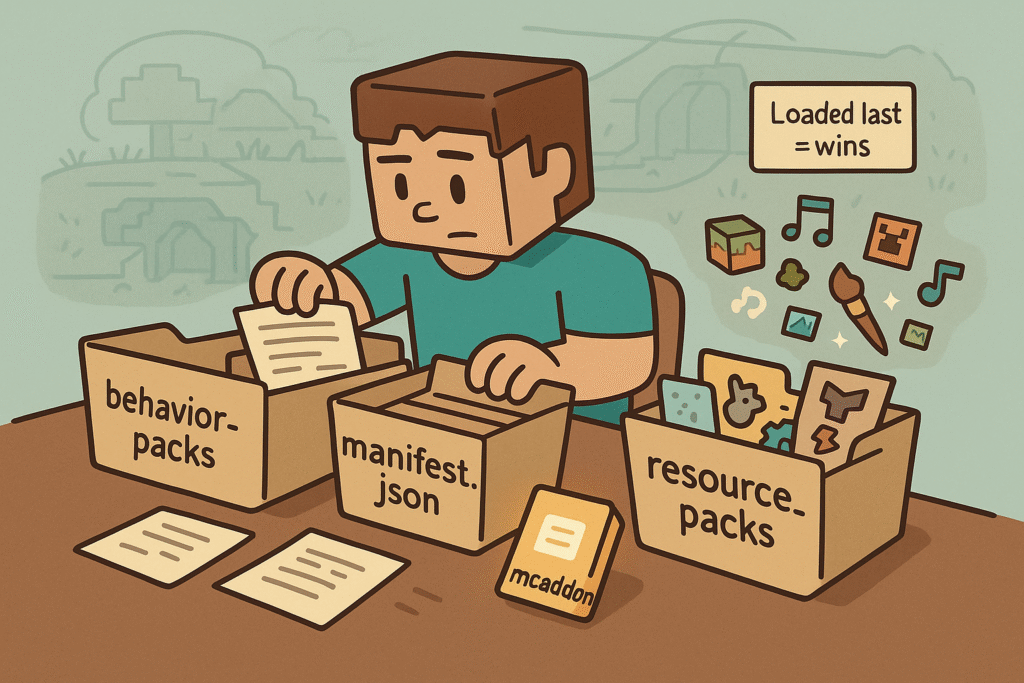You’ve downloaded your first Minecraft addon. Maybe it came as a .mcaddon file. Maybe it unpacked into two mysterious folders called behavior_packs and resource_packs. Maybe you opened it, saw a wall of files, and quietly and slowly backed away.
Let’s fix that.
Understanding how addons actually work doesn’t require deep coding knowledge. Just a clear mental model. In this article, we’ll break down the basics of how Minecraft Bedrock loads addons, what’s inside them, and why it helps to know a little about their structure.
This isn’t a super technical article, this is just an intro to understand the basics about what’s going on.
Addons Are Made of Two Packs
Every addon contains one or both of the following:
- Behavior Pack (BP): Controls what things do (how mobs act, how blocks behave, what recipes exist)
- Resource Pack (RP): Controls how things look and sound (textures, models, sounds, UI elements)
These packs work in unison to change Minecraft’s behavior and appearance. You can use just one, but many addons have (and require) both.
Think of the behavior pack as the engine in a car, and the resource pack as the body and paint job. One controls what the game does, the other controls how it looks.
If you check out the Industrial Revolution addon as an example, you’ll see the behavior (power sources, shafts, gears, tools) along with the resources (block textures, tool sounds, and UI).
What’s Inside These Packs?
Addons are, in technical terms, data-driven models. At a high level, each pack is just a structured folder with a few key ingredients:
- A
manifest.jsonfile, which tells Minecraft the pack’s name, version, and unique IDs - Subfolders like
items/,entities/,textures/,scripts/, andmodels/, each of which contain custom content - Optional metadata like icons and language localization files
How Minecraft Loads Addons
When you launch a world and activate an addon, Minecraft reads the contents of the behavior and resource packs and merges them into the game. The order matters.
Base game content is loaded first.
Packs (both BP and RP) are stacked in load order (top overrides bottom).
Packs build on what was loaded before them. If two packs change the same mob or block, the one loaded later takes priority. It’s like layers in Photoshop. The one on top wins.
Addons can also declare dependencies (for example, a behavior pack might mandate the presence of a specific resource pack). Minecraft will load them together.
What Makes an Addon Work (or Not)
Minecraft expects each pack to follow a specific structure. If the addon is missing a manifest, has files in the wrong place, or contains broken JSON, Minecraft will ignore it. Sometimes with a specific error message, sometimes without. This is one of the things that makes addons safe to use. Except for scripting infinite loops, there’s not much you can do with an addon to break the game so it won’t run.
Quick aside: Yes, I know that’s a gross generalization, and if you can think of a specific case that will do so, that knowledge alone means you’re not the target audience for this article.
That’s why understanding the layout matters. Knowing where to look (and what each folder and file is used for) can save hours of frustration.
Why This Matters
You don’t need to memorize every file type or format, but knowing how addons are structured helps you:
- Troubleshoot why something isn’t loading when you expected it to
- Resolve collision conflicts between two different addons that modify the same file
- Customize existing addons for your own use
- Follow along with tutorials and modding tools
Even if you’re just getting started, this knowledge gives you a sturdy foundation for learning more.
What’s Next?
Ready to take the next step? Try peeking inside one of your favorite addons and see if you can identify the behavior and resource packs. Or check out a breakdown of the manifest.json file to understand how the game reads an addon’s identity.
You’ve already opened the box. Now you’re learning how the pieces fit together.

